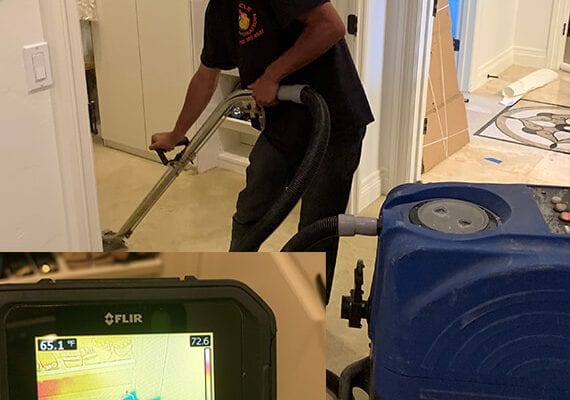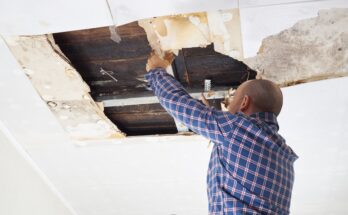Fires are a common occurrence in California and can devastate entire communities. It’s a life-changing experience for those who lose friends or family members, homes or jobs, and some never fully recover.
Those who survived the fire with little or no damage to their home are very fortunate, but recovery may still take some time. This is especially true if the fire is close enough to your home to cause soot, smoke or water damage. Also, even if the fire has never threatened your home, fires from miles away can still accumulate ash and cause your home to smell like smoke.
Professional cleaning and fire restoration services are recommended for homes with severe fire damage or water damage while firefighters defend your home. Depending on when your house was built, it could be asbestos and the water damage could be greater than the amateur eye can see. These are just two examples of why major damage or cleaning must be done by professionals.
Since it’s best to leave the major fire cleanup to professionals, this guide is for homeowners looking for fire cleaning tips to eliminate the effects of ash, soot or smoke in their home and outdoor living spaces.
Fire Damage Restoration Tips: Before You Begin
Before starting any fire cleanup effort, you must make sure the area is safe. Confirm that evacuation orders have been removed and evaluate your property and surrounding area for still smoldering and flammable spots. If your home is in an evacuated area, your local fire chief or law enforcement will tell you if it’s okay to return home to assess the damage and begin cleaning efforts.
If your home or property has suffered damage that you should report to your insurance company, contact your representative immediately to extract a damage corrector to assess the damage before you begin to remove or clean up the debris. Depending on the extent of the damage, your insurance company can arrange and pay for water damage, fire cleaning and repair. At the very least, they will be able to tell you how they want you to document the damage or send repairs and receipts.
If your home has suffered severe fire or water damage, it’s best to hire a company that specializes in this type of cleaning to do the job for you. While this is more expensive than doing it yourself, it is especially important if there is water damage that can lead to mold growth without proper remediation or fire damage that could cause asbestos fibers to be released into the air. Failure to properly clean and restore can make problems worse, increase damage to your home, or put your health at risk.
Fire Damage Restoration Tips : External Ash and Smoke Removal
When cleaning the exterior of your home and your outdoor living spaces, there are two very tempting but don’ts: washing ash into storm drains and using your leaf blower.
It is important to avoid dumping ash into rain gutters whenever possible. This applies to all ashes, but is particularly true for ash caused by fires or building fires that burn anything other than trees and shrubs.
It’s also important that you don’t use a leaf blower to remove ash from your roof, driveway, lawn or other surfaces. This will allow the ash to mix into the air again. In some cases, this can also be a fire hazard because smoldering areas may catch fire, or you can blow embers into a flammable area to ignite.
When cleaning the exterior of your house after a fire, you should start at the top and go down. Therefore, your first stop will be your roof. Use a broom to gently sweep the ashes away in a pile. Collect the ashes in a bag for disposal in the trash can. If this doesn’t get enough of the smaller particles from your roof, you can follow up with a wet mop.
You can use a smaller brush, broom, or scoop to remove ash from your grooves; Be careful not to bother more than necessary so as not to redistribute the ash into the air. You can then use a damp cloth or cloth to wipe your grooves to remove smaller particles. If you have a workshop vacuum cleaner with a particulate filter, you can get a special attachment that allows you to vacuum the ashes in your gutter without dispersing it into the air.
You’ll likely be able to clean ash and light soot from outside walls and windows by spraying it down with a garden hose using a nozzle to direct the water. Pressure washing may be necessary for stubborn stains. So use the lowest possible pressure to get the job done without damaging the wood, stucco, or harsh landscapes nearby. Whenever possible, direct the water to your lawn, flower beds or bare grounds and keep it away from rain gutters.
After removing ash and soot from your windows with a garden hose or pressure washer, you can clean them as usual using your favorite glass cleaner or a mixture of vinegar and water.
If chemical fire retardant has been dropped in your area and you have debris on your walls or windows, you may need to use a stiff brush with dish soap or other mild cleaner to remove the residue. If flame retardant foam is used, you can try removing it first with a scrub brush and dish soap. If that doesn’t work, you can make a mildly abrasive cleaner by mixing baking soda and water.
When it’s time to clean up your harsh environments, such as concrete garage paths, wooden decks, flagstone terraces, or brick walkways, gently sweep the ash in a pile, pack it in bags and throw it into your outdoor trash. Do not use a blower as it will scatter ash into the air. If smaller particles need to be removed additionally, you can wet the surface after sweeping.
How do I clean my house after a fire?
When cleaning the exterior of your house after a fire, you should start at the top and go down. Therefore, your first stop will be your roof. Use a broom to gently sweep the ashes away in a pile. Collect the ashes in a bag for disposal in the trash can. If this doesn’t get enough of the smaller particles from your roof, you can follow up with a wet mop.
How should I clean walls and windows after a fire?
You’ll likely be able to clean ash and light soot from outside walls and windows by spraying it down with a garden hose using a nozzle to direct the water. Pressure washing may be necessary for stubborn stains. So use the lowest possible pressure to get the job done without damaging the wood, stucco, or harsh landscapes nearby. Whenever possible, direct the water to your lawn, flower beds or bare grounds and keep it away from rain gutters.
Additional Resources:
Sun
Ocean


